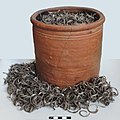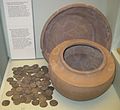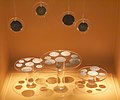Top Qs
Timeline
Chat
Perspective
List of hoards in Great Britain
From Wikipedia, the free encyclopedia
Remove ads
The list of hoards in Britain comprises significant archaeological hoards of coins, jewellery, precious and scrap metal objects and other valuable items discovered in Great Britain (England, Scotland and Wales). It includes both hoards that were buried with the intention of retrieval at a later date (personal hoards, founder's hoards, merchant's hoards, and hoards of loot), and also hoards of votive offerings which were not intended to be recovered at a later date, but excludes grave goods and single items found in isolation. The list is subdivided into sections according to archaeological and historical periods.
Remove ads
Neolithic hoards
Hoards dating to the Neolithic period, approximately 4000 to 2000 BC, comprise stone weapons and tools such as axeheads and arrowheads. Such hoards are very rare, and only a few are known from Britain.
Remove ads
Bronze Age hoards
A large number of hoards associated with the British Bronze Age, approximately 2700 BC to 8th century BC, have been found in Great Britain. Most of these hoards comprise bronze tools and weapons such as axeheads, chisels, spearheads and knives, and in many cases may be founder's hoards buried with the intention of recovery at a later date for use in casting new bronze items. A smaller number of hoards include gold torcs and other items of jewellery. As coinage was not in use during the Bronze Age in Great Britain, there are no hoards of coins from this period.
Remove ads
Iron Age hoards
A large number of hoards associated with the British Iron Age, approximately 8th century BC to the 1st century AD, have been found in Britain. Most of the hoards comprise silver or gold Celtic coins known as staters, usually numbered in the tens or hundreds of coins, although the Hallaton Treasure contained over 5,000 silver and gold coins. In addition to hoards of coins, a number of hoards of gold torcs and other items of jewellery have been found, including the Snettisham Hoard, the Ipswich Hoard and the Stirling Hoard.
In September 2020, 1,300 Celtic gold coins were discovered at a location in eastern England, dated back between 40 and 50 A.D.[3]
Romano-British hoards
Hoards associated with the period of Romano-British culture when part of Great Britain was under the control of the Roman Empire, from AD 43 until about 410, as well as the subsequent Sub-Roman period up to the establishment of Anglo-Saxon kingdoms are the most numerous type of hoard found in Great Britain, and Roman coin hoards are particularly well represented, with over 1,200 known examples. In addition to hoards composed largely or entirely of coins, a smaller number of hoards, such as the Mildenhall Treasure and the Hoxne Hoard, include items of silver or gold tableware such as dishes, bowls, jugs and spoons, or items of silver or gold jewellery.
Remove ads
Anglo-Saxon hoards
Summarize
Perspective
Hoards associated with the Anglo-Saxon culture, from the 6th century to 1066, are relatively uncommon. Those that have been found include both hoards of coins and hoards of jewellery and metalwork such as sword hilts and crosses. The Staffordshire Hoard is the largest Anglo-Saxon hoard to have been found, comprising over 1,500 items of gold and silver. More Anglo-Saxon artefacts have been found in the context of grave burials than hoards in England. These include major finds from Sutton Hoo in Suffolk, Taplow in Buckinghamshire, Prittlewell, Mucking and Broomfield in Essex, and Crundale and Sarre in Kent.
Remove ads
Pictish hoards
Summarize
Perspective
Hoards associated with Pictish culture, dating from the end of Roman occupation in the 5th century until about the 10th century, have been found in eastern and northern Scotland. These hoards often contain silver brooches and other items of jewellery.
Remove ads
Viking hoards
Summarize
Perspective
Hoards associated with the Viking culture in Great Britain, dating from the 9th to 11th centuries, are mostly found in northern England and Orkney, and frequently comprise a mixture of silver coins, silver jewellery and hacksilver that has been taken in loot, some coins originating from as far away as the Middle East.
Remove ads
Later Medieval hoards
Summarize
Perspective
Hoards dating to the later medieval period, from 1066 to about 1500, mostly comprise silver pennies, in some cases amounting to many thousands of coins, although the Fishpool Hoard contains over a thousand gold coins.
Remove ads
Post-Medieval hoards
Summarize
Perspective
Most hoards from the post-medieval period, later than 1500, date to the period of the English Civil War (1642–1651), from which time over 200 hoards are known.[77]
Remove ads
See also
Wikimedia Commons has media related to Hoards from the United Kingdom.
Notes
- The hoard was uncovered when preparing a burial ground in an area called Harkirke, or Harkirk (meaning "hoary or grey church"), which is now park land. The only record of the coins was a copperplate engraving of thirty five of them which was reproduced in a book by John Spelman, published in 1678.
- The Ainsbrook Hoard is named after the two men who discovered the hoard, Mark Ainsley and Geoffrey Bambrook; it was covered in a special episode of the Channel 4 programme Time Team, first broadcast 14 January 2008. The programme was sceptical about the Viking origins of the hoard, and the location of the find was initially kept secret "to avoid the location becoming known to unscrupulous 'nighthawk' detectorists".[27]
- The Eye hoard was not declared to the Portable Antiquities Scheme, but was illegally sold to dealers by the finders, who were convicted of theft and concealing the find in 2019. Only 31 of the coins, a silver ingot, and three pieces of jewellery have been recovered.[34]
- The Mason Hoard is named after its discover, Richard Mason, a builder who found the jug when working on an extension to a modern house in Lindisfarne; he did not realize the jug contained any coins until 2011. The Mason hoard was found at exactly the same location that the 1962 Short Hoard had been found at.
- The Short Hoard is named after its discover, Alan Short, a builder who found the jug when working on a modern house in Lindisfarne. The Mason Hoard was found at the same location in 2003.
Remove ads
Footnotes
References
External links
Wikiwand - on
Seamless Wikipedia browsing. On steroids.
Remove ads





































